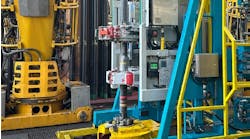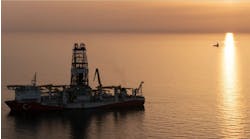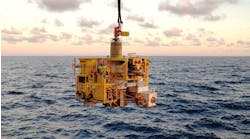Leta K. Smith, PhD, IHS
As companies confront the issue of access to resources, they are moving into increasingly technically challenging environments. Ultra deepwater is one such area, and the arctic is another.
Drilling in water depths in excess of 1,000 m (3,280 ft) is now typical, and companies have drilled in waters as deep as 3,000 m (9,843 ft). Although the arctic is hardly a new exploration province, it is enjoying a new era of activity, and with that come new challenges, both technical and commercial. Companies continue to invest in those areas where resource estimates range into the hundreds of billion boe.
New trends in an old province
The arctic (north of the Arctic Circle) is a busy place again, but there has been a shift in the locus of activity. Exploration drilling tells the story. Before 1980, Canada’s Mackenzie Delta dominated, with 50% of the exploration wells drilled. Exploration drilling shifted to Russia, peaking in 1986 when Russian exploration wells accounted for 59% of the 78 arctic exploration wells drilled. More recently, exploration activity has shifted back toward the US and Canada. Since 2000, 149 exploration wells have been drilled in the arctic - 57 in the US, 51 in Russia, 23 in Canada, and 18 in Norway.
The exploration effort has not been without success, but commerciality is one of the biggest challenges for the arctic, with 80% of the discovered reserves being gas. Although two-thirds of the gas is developed or developing, 424 tcf of gas remains stranded. This represents 25% of the world’s total undeveloped gas. In the meantime, large oil discoveries continue to be made, such as BP’s Orion (Alaska) and the Vankorskoye Severnoye field in western Siberia.
There are signs that the issue of gas commerciality is diminishing. Later this year, Statoil’s Snøhvit project in the Barents Sea with 6.5 tcf recoverable gas is expected to come onstream with the completion of the LNG plant at Melkøya. This project has been long in the making because of commerciality and market access issues.
The first of the three fields was discovered in 1981. Current plans began in 1997, and construction of the Melkøya plant began in 2001. The completion of the LNG plant opens the possibility of further gas development in the region. On the Russian side of the Barents Sea, Gazprom announced in late 2006 that it would develop the super giant 86 tcf Shtokmanovskoye discovery with a planned onstream date of 2013. This date could slip, however, as Gazprom is adding foreign partners to share the risk and provide technology.
Estimates of the undiscovered resource potential in the arctic vary, but all of the numbers support a substantial resource.
Turning arctic resources into reserves presents technical challenges, too. One of the biggest is the number of travel days allowed on the tundra. In Alaska, the average travel days today are roughly half that of 30 years ago. Although a technical challenge for drilling, it has opened arctic waterways to shipping and non-drilling exploration activity. The reduction in travel days could account for the increasingly shallow drilling targets during the past 30 years, as companies have fewer days to mobilize and de-mobilize their rigs. Average drilling depths declined from 3,205 m (10,515 ft) in 1987 to 1,281 m (4,203 ft) in 2005. The trend of shallower drilling targets appears to be reversing, however. In 2006, the average was 2,309 m (7,575 ft), and so far in 2007, it has been 2,029 m (6,657 ft).
With technology advancing, companies are exploring increasingly deep water. For wells drilled off the continental shelf, the average water depth has more than doubled from an average of 501 m (1,644 ft) in 1985 to 1,312 m (4,304 ft) in 2003. This is being driven by downdip exploration to the toes of the major depositional systems, which are in ultra deepwater, here defined as >2,000 m (6,562 ft). Since drilling in ultra deepwater took off in the late 1990s, approximately 170 exploratory wells have been drilled. The number peaked at 32 in 2004, but has declined in subsequent years. The reasons are complex and vary by country.
In Brazil, the acreage situation is one constraint. Petrobras is still drilling its Round 0 blue blocks, which face stiff relinquishment schedules and are mostly in shallower water. Petrobras also is focused on getting its existing discoveries online, with six major developments under way.
Global rig availability is another constraint. There are only 36 vessels in the world capable of drilling in water deeper than 2,000 m (6,562 ft). All of them are under long-term contracts.
In the US, another issue is the focus on appraisal drilling. In 2006, the number of appraisal wells drilled equaled the number of exploration wells drilled the previous year. Drilling costs are another key factor. Deepwater rig rates are approaching $500,000/day, with typical total well costs of $50-$100 million.
Finally, places such as Kenya, where Woodside’s dry hole is the only ultra deepwater well in the Kamu basin, exploration activity may be suffering from lack of success.
Once the exclusive domain of the US, exploration drilling in ultra deepwater now extends to 18 countries, with proven reserves found offshore eight of them. Still, the US and Brazil together account for 74% of the 7.2 Bboe of discovered reserves.
As a result of less ultra deepwater exploration drilling over the past couple of years, there also has been a decline in new discoveries. The year 2004 was the peak for discoveries in ultra deepwater, with 1.2 Bboe recoverable reserves found - Chevron’s Jack discovery accounts for about one-third of that.
Exploring the ultra deep
Exploration drilling in ultra deepwater may eventually pick up. Relief appears to be in sight for the rig shortage problem, with approximately 60 ultra deepwater rigs on order or under construction. The IHS global database of high-impact exploration prospects indicates that 20-30 wells will be drilled in ultra deepwater in the next few years; some areas have had recent exploration success that could drive additional exploration. For example, the Mahogany discovery in Ghana, estimated to hold 250 MMbbl recoverable, is likely to encourage further exploration along trend into ultra deepwater.
Discovered reserves, however, do not necessarily translate into production, as ultra deepwater also faces commerciality issues. Only eight of 63 discoveries in ultra deepwater, representing 1.2 Bboe, are in production today. Seven of these are in the US. Nevertheless, development is moving ahead with 1.1 Bboe in 15 discoveries undergoing development and another 418 MMboe awaiting development approval.
Furthermore, countries, if not companies, still are bullish on ultra deepwater. There are four countries promoting bid blocks with an ultra deepwater component, plus another 14 countries with open areas. No uniform resource estimates are available for ultra deepwater alone; IHS estimates that globally deepwater basins may have yet-to-find as high as 800 Bboe of potentially recoverable reserves. On a more regional level, the US Minerals Management Service (MMS) estimates that the deepwater Gulf of Mexico contains up to 78 Bboe of undiscovered technically recoverable reserves.
Places, players to watch
Medium-sized companies and nat- ional oil companies are joining super-majors in many technically challenging environments.
In the Alaskan arctic, Talisman, for example, could be opening a new area with the recently announced Aklaq and Aklaqyaaq oil discoveries, if they prove to be commercial. The wells were targeting Permo-Triassic sands that are part of the same trend as the Kuparuk River, Point Thompson, and Niakuk fields to the east. ConocoPhillips also is working to open new areas. The Noatak-1 discovery, announced earlier this year, which also targeted Jurassic and Permo-Triassic reservoirs, contains an estimated 250 MMboe of recoverable reserves. This discovery is more than 60 mi (97 km) from existing infrastructure at Alpine.
Another area to watch is the US Beaufort Sea. In April, the MMS announced the preliminary award of 92 offshore tracts to six companies from the bid round held earlier in the year. The MMS estimated that the original 9.7 million acres offered could contain as much as 7 Bbbl oil and 32 tcf gas.
On the other side of the arctic, Russia has awarded 57% of all acreage above the Arctic Circle in the past five years.
In the Norwegian sector of the Barents Sea, Hydro (now Statoil-Hydro) recently announced the results of the Nucula prospect, which contains an estimated >300 MMbbl recoverable oil. If subsequent appraisal deems it economic, Nucula will be the first commercial discovery in the Barents Sea since 2000.
In ultra deepwater, there are a number of promising areas to watch. As of this writing, eight exploration wells are active in water depths greater than 2,000 m (6,562 ft) offshore Angola, Brazil, Egypt, and the US. In the US deepwater GoM, companies are pursuing the Eocene trend with high expectations. ExxonMobil, BHP, and Andadarko are exploring the trend while Shell, Chevron, and BP develop the Perdido Hub made up of the Great White, Tobago, Trident, and Silvertip fields.
In the Santos basin off Brazil, only one ultra deepwater discovery has been made so far - Petrobras’ 1-RJS-628A estimated to contain 250 MMbbl oil. Like the Eocene Trend in the deepwater GoM, the Petrobras discovery is a play opener, and the company is drilling another well in the trend.
In Angola, BP has two ultra deepwater discoveries, and both BP and Total continue to push that trend into deeper water. In Egypt, Shell continues to explore the Pliocene deltas in ultra deepwater, where it already has two discoveries, each holding an estimated 1 tcf of gas. Adding this to the shallower deepwater finds to date gives Egypt approximately 60 tcf of gas.
Bid rounds under way in Cyprus and Lebanon include a portion of ultra deepwater acreage. And Noble is slated to drill a well in 1,600 m (5,249 ft) of water offshore Israel. Should the well be successful, it will have implications for deepwater and ultra deepwater exploration throughout the eastern Mediterranean.
In addition to the currently active wells, several other ultra deepwater prospects are being pursued. In India, ONGC is expanding its ultra deepwater push following a discovery late last year that contains an estimated 20 tcf of gas in place.
In an even more challenging ultra deepwater environment, offshore Newfoundland is another area to watch. Earlier this year, Chevron drilled the Great Barasway prospect for a reported $200 million. The structure contains an estimated several Bbbl of oil in place, but it is 350 km (217 mi) from the coast in 2,400 m (7,874 ft) water depth. Drilling results have not been reported, and rig availability has pushed appraisal drilling to 2008 or 2009.
Arctic meets ultra deep
Both the arctic and ultra deepwater face interesting challenges. The arctic has large proven reserves plus large additional potential in yet-to-find resources, but significant portions of the arctic are gas-prone. Although technical challenges exist, a bigger issue may be in getting product to market, at least for the US and Canada. For the ultra deepwater environment, the resource base appears to be large, but very little is proven so far. Exploration in ultra deepwater is in a very immature stage, but it is growing fast as technical challenge are overcome.
There are wells in ultra deepwater, and there are wells in the arctic, but currently there are no ultra deepwater arctic wells aside from shallow drill-depth ODP stratigraphic test wells. But that’s changing.
Exploration drilling in the arctic is pushing water depth limits, and ultra deepwater exploration is moving north as companies continue their hunt for the regions’ vast resources.
Exploration in these two challenging environments may soon meet, and when they do, it will be an exciting time for the industry as new technical and commercial challenges are overcome to turn these resources into recoverable reserves.







